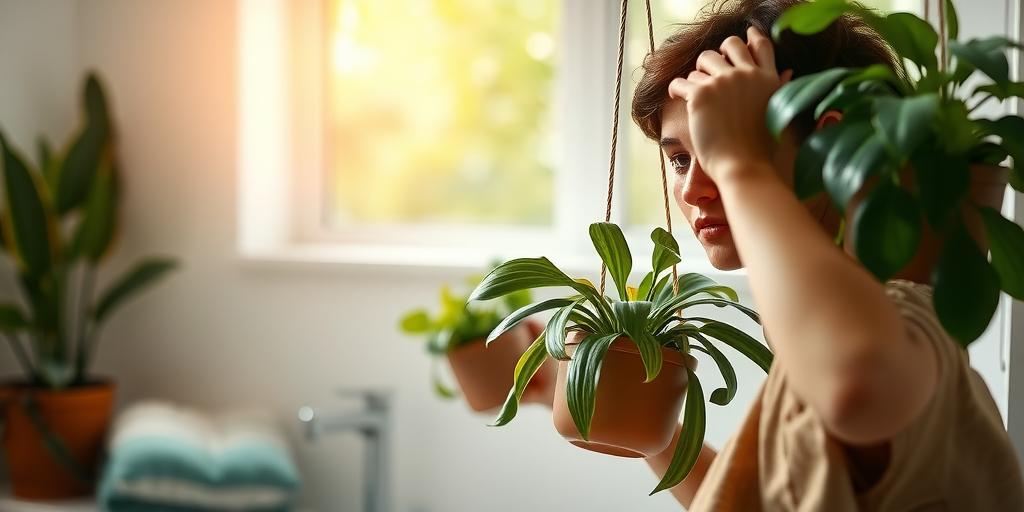
Essential Care Tips for Low Light Hanging Plants in Bathrooms
Discover the best low light hanging plants for bathrooms and learn essential care tips to keep them thriving! Perfect for adding greenery to dim spaces.
Introduction
Did you know that bathrooms are one of the best spots for low light hanging plants? Thanks to their humidity and often subdued lighting, these spaces can become lush, green sanctuaries—even without direct sunlight! Whether you’re a plant newbie or a seasoned green thumb, this guide will walk you through the best low light hanging plants for bathrooms and how to care for them. Let’s turn your bathroom into a tropical retreat!
Best Low Light Hanging Plants for Bathrooms
Pothos (Epipremnum aureum)
If you’re new to houseplants, pothos is the perfect place to start. This hardy vine thrives in low light and can tolerate occasional neglect. Its heart-shaped leaves come in various shades, from deep green to variegated yellow and white. Pothos grows quickly, making it great for hanging baskets where its vines can cascade beautifully. Plus, it helps purify the air—a bonus for any bathroom.
Spider Plant (Chlorophytum comosum)
Spider plants are practically indestructible, making them ideal for bathrooms. They love humidity and can adapt to lower light conditions. Their arching leaves and tiny “spiderettes” (baby plants) add a fun, lively touch. Another perk? They’re excellent at removing toxins like formaldehyde from the air. Just be sure to keep them out of direct sunlight, which can scorch their leaves.
Philodendron Heartleaf
Another forgiving plant, the heartleaf philodendron, is perfect for bathrooms with limited light. Its glossy, heart-shaped leaves trail elegantly from hanging pots, creating a lush, tropical vibe. It’s low-maintenance—just water when the top inch of soil feels dry. If you notice slower growth, it might need a bit more indirect light, but it generally does well in dimmer spaces.
String of Pearls (Senecio rowleyanus)
For a more unique look, try a string of pearls. This trailing succulent features bead-like leaves that drape beautifully from hanging planters. While it prefers bright, indirect light, it can tolerate lower light if given occasional exposure to brighter conditions. Be careful not to overwater—succulents store moisture in their leaves, so let the soil dry out between waterings.
Ferns (e.g., Boston Fern)
Ferns are classic bathroom plants because they adore humidity. The Boston fern, in particular, thrives in moist, low-light environments. However, they do need consistent moisture—don’t let the soil dry out completely. If your bathroom lacks natural light, consider supplementing with a grow light to keep your fern happy.
Ideal Bathroom Conditions for Hanging Plants
Light Requirements
Most bathroom-friendly hanging plants prefer indirect or filtered light. A frosted window or a spot a few feet away from a natural light source works well. If your bathroom has no windows, opt for low-light champions like pothos or snake plants (though snake plants prefer drier conditions).
Humidity Levels
Bathrooms naturally have higher humidity, which tropical plants love. Plants like ferns, orchids, and philodendrons thrive in this environment. If your bathroom tends to be dry (e.g., due to strong ventilation), consider grouping plants together or using a small humidifier to maintain moisture levels.
Temperature
Aim to keep your bathroom between 60-75°F (15-24°C). Most houseplants prefer this range, though some, like orchids, may need slightly warmer conditions. Avoid placing plants near drafty windows or heating vents, as sudden temperature changes can stress them.
Airflow
While humidity is great, stagnant air can lead to mold or pest problems. Crack a window occasionally or run the exhaust fan to promote gentle airflow. This helps prevent fungal growth while keeping your plants healthy.
Watering and Feeding Tips
Watering Frequency
Overwatering is the most common mistake with bathroom plants. Check the soil weekly—stick your finger an inch deep. If it’s dry, it’s time to water. Plants like ferns and peace lilies prefer consistently moist soil, while succulents (like string of pearls) need less frequent watering.
Drainage
Always use pots with drainage holes to prevent root rot. If your hanging planter doesn’t have holes, place a nursery pot inside it and remove it to water, letting excess water drain before putting it back.
Fertilizing
During the growing season (spring and summer), feed your plants with a diluted liquid fertilizer once a month. Reduce feeding in fall and winter when growth slows. Over-fertilizing can harm plants, so less is more.
Misting
Some plants, like ferns and orchids, benefit from occasional misting to boost humidity. However, avoid misting plants with fuzzy leaves (e.g., African violets), as water droplets can cause spotting or rot.
Common Problems and Solutions
Yellow Leaves
Yellowing leaves often signal overwatering or poor drainage. Check the soil—if it’s soggy, let it dry out and adjust your watering schedule. If the roots are mushy, trim the damaged parts and repot in fresh soil.
Brown Tips
Brown leaf tips usually mean low humidity or chemicals in tap water. Try using filtered or distilled water, or let tap water sit overnight before watering. Increase humidity by misting or placing a tray of water near your plants.
Pests
Spider mites and fungus gnats are common in humid environments. Wipe leaves with a damp cloth to remove pests, and treat infestations with neem oil or insecticidal soap. For fungus gnats, let the soil dry out more between waterings and use sticky traps.
Leggy Growth
If your plant looks stretched or sparse, it might need more light. Move it closer to a window or rotate it regularly for even growth. Pruning leggy stems can also encourage bushier growth.
Creative Display Ideas for Hanging Plants
Macramé Hangers
Macramé hangers add a bohemian flair to your bathroom while keeping plants at eye level. They’re perfect for trailing plants like pothos or philodendrons. Choose a spot near a window or in a well-lit corner for the best effect.
Wall-mounted Shelves
Install floating shelves to display cascading plants like string of pearls or spider plants. This works especially well in small bathrooms where floor space is limited. Mix and match different plant varieties for a dynamic look.
Tension Rods
No drilling required! A tension rod across a window or between walls can support lightweight hanging planters. This is a great temporary solution for renters or those who like to rearrange often.
Glass Terrariums
Terrariums create a mini greenhouse effect, ideal for humidity-loving ferns, mosses, or air plants. Hang them near a window or place them on a shelf for a stylish, low-maintenance display.
By choosing the right plants and providing proper care, you can transform your bathroom into a lush, relaxing oasis—even in low light.
Conclusion
Transforming your bathroom into a green oasis with low light hanging plants is easier than you think! By choosing the right plants, maintaining proper humidity, and following simple care routines, you can enjoy lush, thriving greenery year-round. Ready to get started? Pick your favorite plant, grab a stylish hanger, and let nature elevate your space!
